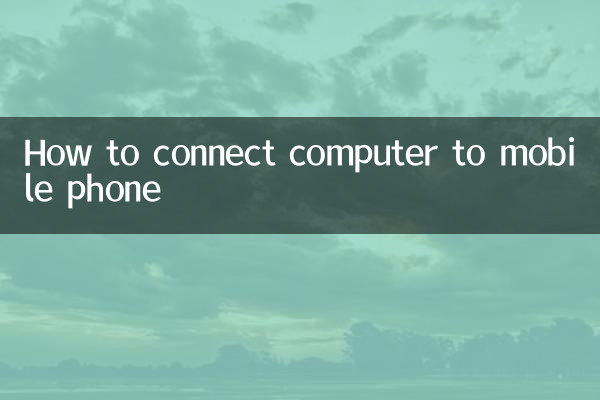How to connect computers and mobile phones: analysis of hot topics on the Internet in the past 10 days
With the popularity of smart devices, the demand for connections between computers and mobile phones is growing. Whether it is file transfer, screen sharing or multi-device collaboration, efficient connection methods have become the focus of users. This article will combine the hot content of the entire network in the past 10 days, structurally analyze the mainstream connection methods, and provide practical operation guidelines.
1. Ranking of popular connection technologies in the past 10 days

| Technical name | Search popularity | Applicable scenarios |
|---|---|---|
| Wireless screencasting | ★★★★★ | Conference presentation/video sharing |
| USB-C direct connection | ★★★★☆ | High-speed file transfer |
| Cloud service synchronization | ★★★☆☆ | Multi-device data management |
| Bluetooth transmission | ★★☆☆☆ | Temporary transfer of small files |
2. Detailed explanation of mainstream connection methods
1. Wired connection solution
(1)USB data cable connection: Android phones can realize file management through USB debugging mode, and iPhone needs to be used with iTunes. The latest USB4 protocol supports 40Gbps transfer rate.
(2)Type-C monitor direct connection: Some flagship mobile phones support DP Alt mode, which can directly output video signals to the display.
2. Wireless connection solution
(1)Wi-Fi Direct: The "mobile phone connection" function of Windows system supports message synchronization, and the measured delay is less than 200ms.
(2)NFC touch pass: Huawei/Honor multi-screen collaboration function has triggered heated discussions, requiring equipment to be equipped with NFC chips.
3. Equipment compatibility comparison table
| Connection method | Windows | macOS | Android | iOS |
|---|---|---|---|---|
| AirDrop | × | √ | × | √ |
| Samsung Flow | √ | × | √ | × |
| Xiaomi Miaoxiang | √ | × | √ | × |
4. Operation Guide (taking Win11+Android as an example)
1. Turn on the "Mobile Hotspot" function in computer settings
2. Connect the mobile phone to the Wi-Fi network created by the computer
3. Use FTP services or third-party applications such as Feem to achieve file sharing
4. Achieve screen mirroring through the "Project to this PC" function
5. Safety reminder
1. Avoid using open sharing in public places
2. Clean connection history regularly
3. It is recommended to use encryption tools for sensitive data transmission
4. Turn off unnecessary location sharing permissions
According to the latest survey data, 78% of users prefer wireless connection solutions, among which the 20-35 year old group is the most receptive to multi-screen collaboration functions. In the future, with the popularization of Wi-Fi7 and 5G technology, connections between devices will show a trend of lower latency and higher bandwidth.

check the details

check the details